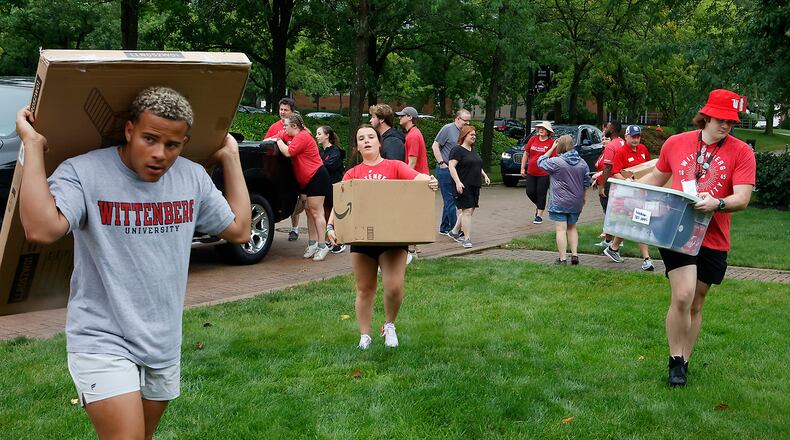Fall undergraduate enrollment increased by 2.1% this fall compared to last year and 1.2% compared to 2021 enrollments, according to the National Student Clearinghouse. However, community colleges accounted for 58.9% of the increase in undergraduate enrollment.
Graduate enrollment also slightly increased this fall by 0.7%, with continued enrollment growth in graduate certificate programs at 5.7% this year, according to the Clearinghouse.
“This is good news for community colleges and for the growing numbers of continuing and returning students who had lost momentum from the start of the pandemic,” said Douglas Shapiro, Executive Director of the National Student Clearinghouse Research Center. “In a more troubling sign, however, the initial recovery among freshmen last year appears to have stalled as more 18-to 20-year-olds, especially at four-year institutions, are opting out.”
At Wittenberg, undergraduate enrollment this fall was 1,288 students, a 30-student increase from last year’s 1,258, but a two-student increase from 2021. Graduate enrollment has increased over the last two years with 55 this fall, 41 last year and 40 in 2021.
“Students and families continue to be both price-sensitive as well as outcomes-aware — this has remained consistent both before and during the pandemic,” said Maribeth Stevens, vice president of enrollment management.
“Institutions must also be prepared to meet the unique needs of students who spent their entire high school careers affected by COVID in one way or another. Highly individualized support services, both academic and social, will be critical to ensuring their continued success in higher education.”
Clark State College has experienced stable enrollment since the start of the COVID-19 pandemic. Total enrollment slightly increased this fall at 4,725 students compared to last year’s 4,704 students. The college is seeing strong retention rates, specifically in nursing, manufacturing programs and non-credit trainings.
“Clark State is up 6% with continuing students, when compared to this time last year. This is encouraging to us because completion is so critical for student success and graduation,” said Dawayne Kirkman, vice president of student affairs, and Travis Binkley, dean of enrollment services, in a statement.
“I think Clark State sets itself apart by being an accessible/open enrollment institution, affordable/low cost, and high quality in bachelor, associate, and certificate programs... It is our belief that students can do this, that students belong here, that students have a purpose. This belief impacts student success.”
Even though overall undergraduate enrollment grew across the country, freshman enrollment declined by 3.6%, reversing last fall’s increase of 4.6%.
Almost all freshman declines happened in bachelor’s programs at public and private nonprofit four-year institutions with 6.9% and 4.7%, respectively, also reversing last year’s increase. However, freshmen at community colleges and similar institutions largely stabilized after their increase last year at 0.2% and 0.3%, respectively.
Wittenberg’s first-year undergraduate enrollment also slightly decreased this fall, following the national trend, but increased from 2021. There were 383 students this fall, compared to 405 last year and 358 in 2021.
“This fall, we are seeing the continued interest from students seeking shorter-term programs, with the majority of growth coming from certificate programs and community colleges. We are certainly optimistic about the growth in students pursuing these programs, but also must work diligently toward ensuring that students have the opportunity to then transition into a four-year degree program seamlessly,” Stevens said.
Nationally, students continue to gravitate towards shorter-term credentials, with enrollments in undergraduate certificate programs increasing 9.9% compared to 3.6% for associate degrees and 0.9% for bachelor’s degrees over last year, according to the Clearinghouse.
At Clark State, there are more students seeking associate (2,679 versus 2,656), bachelor’s (95 versus 60) and non-degrees (1,589 versus 1,587) than last fall, but fewer are seeking certificates (362 versus 401).
To help with new students and retention, Kirkman and Binkley said the college continues to offer on campus activities with student life and enrollment events, increased visitation from high school partners to let students experience campus life post-pandemic, and held a series of over 20 enrollment events this past summer to help students all enrollment steps.
Onboarding through support services is also stronger at the college, officials said. Normally, students would be into their first semester before being connected with resources, but now they are being introduced before the semester begins.
“Our intention is to better inform our students and provide information earlier to prevent barriers from escalating. Addressing challenges earlier allows students more time and energy to dedicate to learning,” Kirkman and Binkley said. “Through our holistic approach, we present services in such a way to students that asking for help is normalized.”
About the Author

